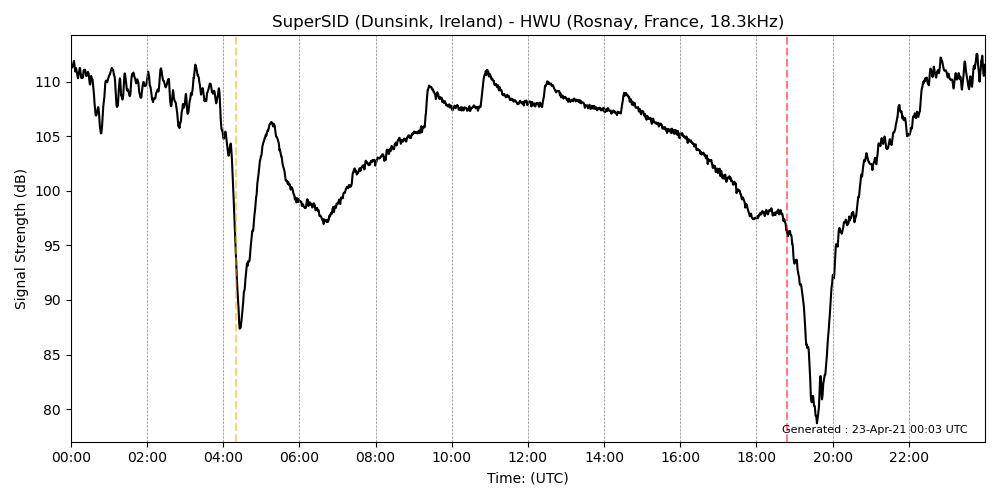A Python 3 package aimed to process and archive Very Low Frequency Sudden Ionospheric Disturbance data produced by the Stanford SID & SolarSID Monitors. The config.py file must contain the correct data & archive directory paths in order to function as intended. Installation & configuration instructions alongside a "How To Guide" on the SIDpy package may be found below.

- Open the chosen OS terminal (Mac/Linux/Windows).
- The package may be installed using pip directly from GitHub using the following terminal command:
pip install git+https://github.com/TCDSolar/SIDpy - The package should now be installed within the current python environment. To verify
pip show sidpymay be ran, if an exception does not occur the SIDpy package is present and the installation has been successful
- Open the chosen OS terminal (Mac/Linux/Windows).
- Run
pip show sidpy - Information on the local installation of the SIDpy package should be returned, including Name, Version, Summary, Home-page, etc...
- If an Exception is raised the SIDpy package has not been properly installed to rectify this follow the steps contained within the Instillation Guide outlined above.
- Run
- The location field specifies the directory where the local installation is held. Using your OS file explorer navigate to this specified directory.
- From here open "./config/config.py".
- The Python dict
transmitterscontains the currently supported transmitters. If your data set contains additional transmitters they must be added in the format:'{Transmitter_ID}': [{Latitude}, {Longitude}, '{Location}'] - Additional
transmittersmay be added to the dictionary depending on the data being processed.
This guide will show how to configure, plot and archive basic Very Low Frequency Sudden Ionospheric Disturbance data produced by the Stanford SID & SolarSID Monitors.
To install please follow the above installation guide. Once installed correctly, SIDpy may be imported into any standard Python3 script.
import sidpy.run as sidExample data may be obtained from the Dublin Institute for Advanced Studies at https://vlf.ap.dias.ie/data using the
following code snippet,
import pandas as pd
import requests
from pathlib import Path
url = 'https://vlf.ap.dias.ie/data/dunsink/super_sid/2021/04/22/csv/Dunsink_HWU_2021-04-22_000000.csv'
req = requests.get(url)
url_content = req.content
file = 'Dunsink_HWU_2021-04-22_000000.csv'
csv_file = open(file, 'wb')
csv_file.write(url_content)
csv_file.close()Once Obtained Sidpy may then be used to plot and archive all data contained within a directory:
sid.process_directory([Path.cwd()], Path.cwd() / './data')Or just a single file:
sid.process_file(Path(file), Path.cwd() / './data')In both cases the data and processed pngs should be found at
./data/dunsink/super_sid/2021/04/22/png/Dunsink_HWU_2021-04-22_000000.png:

This project is Copyright (c) Oscar Sage David O'Hara and licensed under the terms of the Mozilla Public License. This package is based upon the Openastronomy packaging guide which is licensed under the BSD 3-clause licence. See the licenses folder for more information.
We love contributions! SIDpy is open source, built on open source, and we'd love to have you hang out in our community.
Imposter syndrome disclaimer: We want your help. No, really.
There may be a little voice inside your head that is telling you that you're not ready to be an open source contributor; that your skills aren't nearly good enough to contribute. What could you possibly offer a project like this one?
We assure you - the little voice in your head is wrong. If you can write code at all, you can contribute code to open source. Contributing to open source projects is a fantastic way to advance one's coding skills. Writing perfect code isn't the measure of a good developer (that would disqualify all of us!); it's trying to create something, making mistakes, and learning from those mistakes. That's how we all improve, and we are happy to help others learn.
Being an open source contributor doesn't just mean writing code, either. You can help out by writing documentation, tests, or even giving feedback about the project (and yes - that includes giving feedback about the contribution process). Some of these contributions may be the most valuable to the project as a whole, because you're coming to the project with fresh eyes, so you can see the errors and assumptions that seasoned contributors have glossed over.
Note: This disclaimer was originally written by Adrienne Lowe for a PyCon talk, and was adapted by supersid based on its use in the README file for the MetPy project.